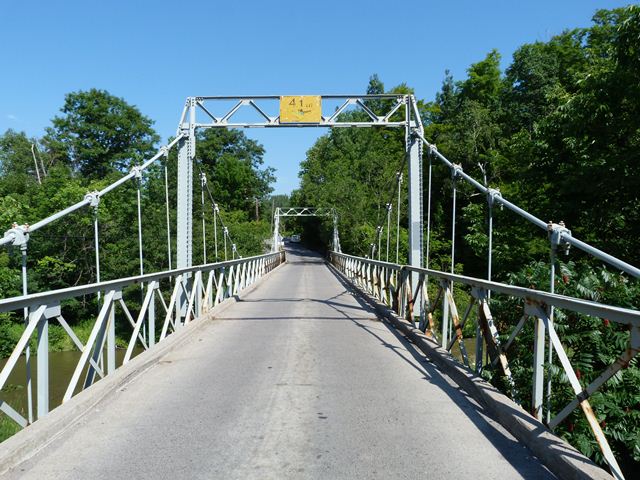We Recommend:
Bach Steel - Experts at historic truss bridge restoration.
BridgeHunter.com Phase 1 is released to the public! - Visit Now
Sewells Road Bridge

Primary Photographer(s): Nathan Holth and Rick McOmber
Bridge Documented: July 23, 2012 and April 6, 2018
Toronto: Toronto City, Ontario: Canada
1912 By Builder/Contractor: Unknown and Engineer/Design: Frank Barber of Toronto, Ontario
1981
100.0 Feet (30.5 Meters)
160.0 Feet (48.8 Meters)
Not Available
3 Main Span(s)
Not Applicable

View Information About HSR Ratings
Bridge Documentation
This bridge is an extremely rare example of a suspension bridge in Ontario, particularly a small-scale example. Suspension bridges were generally used for the largest of spans, and their use in shorter crossings like this one were generally limited. This bridge is also noteworthy for a product of noted local engineer Frank Barber.
This bridge today suffers from a substantial loss of original material and historic integrity. The bridge was rehabilitated, however this rehabilitation replaced a majority of the original bridge material, and in some cases did not replace it with a replica of the original. Based on HistoricBridges.org's observations, it appears that the only original material on this bridge is the posts for the towers (the tower bracing is not original) and possibly the anchorages that the main cables attach to. The substructure may also be original. The original stiffening truss has been removed and replaced. The original stiffening truss featured riveted connections, reflecting the period in which it was constructed. The replacement stiffening truss uses the same double-intersection Warren truss design as the original and also uses angles to compose the truss web, just like the original. However the replacement trusses use the modern method of welding for connections. Also, a horizontal bar that ran through the middle of the stiffening truss a short distance above the intersection of the diagonals has been omitted in the replacement stiffening truss. The bridge also originally had four concrete posts at each corner of the bridge which the main cables ran through. These concrete posts have been removed and replaced. The replacement posts are more like saddles, where the cable simply rests on top of a guide in the post. The main cables also appear to have been replaced. The replacement main cables appear to be composed of smaller cable bundles twisted together, and do not match the twisting pattern of the original cables.
As seen today, the bridge remains a rare example of its type, and it still provide a certain degree of interpretive value into the engineering thinking of Frank Barber and early 20th Century engineering. However, it would have been nice to see a greater effort put toward maintaining the original material of the bridge during rehabilitation, and when something needed to be replaced, it would be nicer to see if replaced with an exact replica.
This bridge is tagged with the following special condition(s): Unorganized Photos
![]()
Photo Galleries and Videos: Sewells Road Bridge
Bridge Photo-Documentation
Original / Full Size PhotosA collection of overview and detail photos. This gallery offers photos in the highest available resolution and file size in a touch-friendly popup viewer.
Alternatively, Browse Without Using Viewer
![]()
Bridge Photo-Documentation
Mobile Optimized PhotosA collection of overview and detail photos. This gallery features data-friendly, fast-loading photos in a touch-friendly popup viewer.
Alternatively, Browse Without Using Viewer
![]()
Northbound Crossing
Full Motion VideoStreaming video of the bridge. Also includes a higher quality downloadable video for greater clarity or offline viewing.
![]()
Southbound Crossing
Full Motion VideoStreaming video of the bridge. Also includes a higher quality downloadable video for greater clarity or offline viewing.
![]()
Additional Unorganized Photos
Original / Full Size PhotosA supplemental collection of photos that are from additional visit(s) to the bridge and have not been organized or captioned. This gallery offers photos in the highest available resolution and file size in a touch-friendly popup viewer.
Alternatively, Browse Without Using Viewer
![]()
Additional Unorganized Photos
Mobile Optimized PhotosA supplemental collection of photos that are from additional visit(s) to the bridge and have not been organized or captioned. This gallery features data-friendly, fast-loading photos in a touch-friendly popup viewer.
Alternatively, Browse Without Using Viewer
![]()
Maps and Links: Sewells Road Bridge
Coordinates (Latitude, Longitude):
Search For Additional Bridge Listings:
Additional Maps:
Google Streetview (If Available)
GeoHack (Additional Links and Coordinates)
Apple Maps (Via DuckDuckGo Search)
Apple Maps (Apple devices only)
Android: Open Location In Your Map or GPS App
Flickr Gallery (Find Nearby Photos)
Wikimedia Commons (Find Nearby Photos)
Directions Via Sygic For Android
Directions Via Sygic For iOS and Android Dolphin Browser



